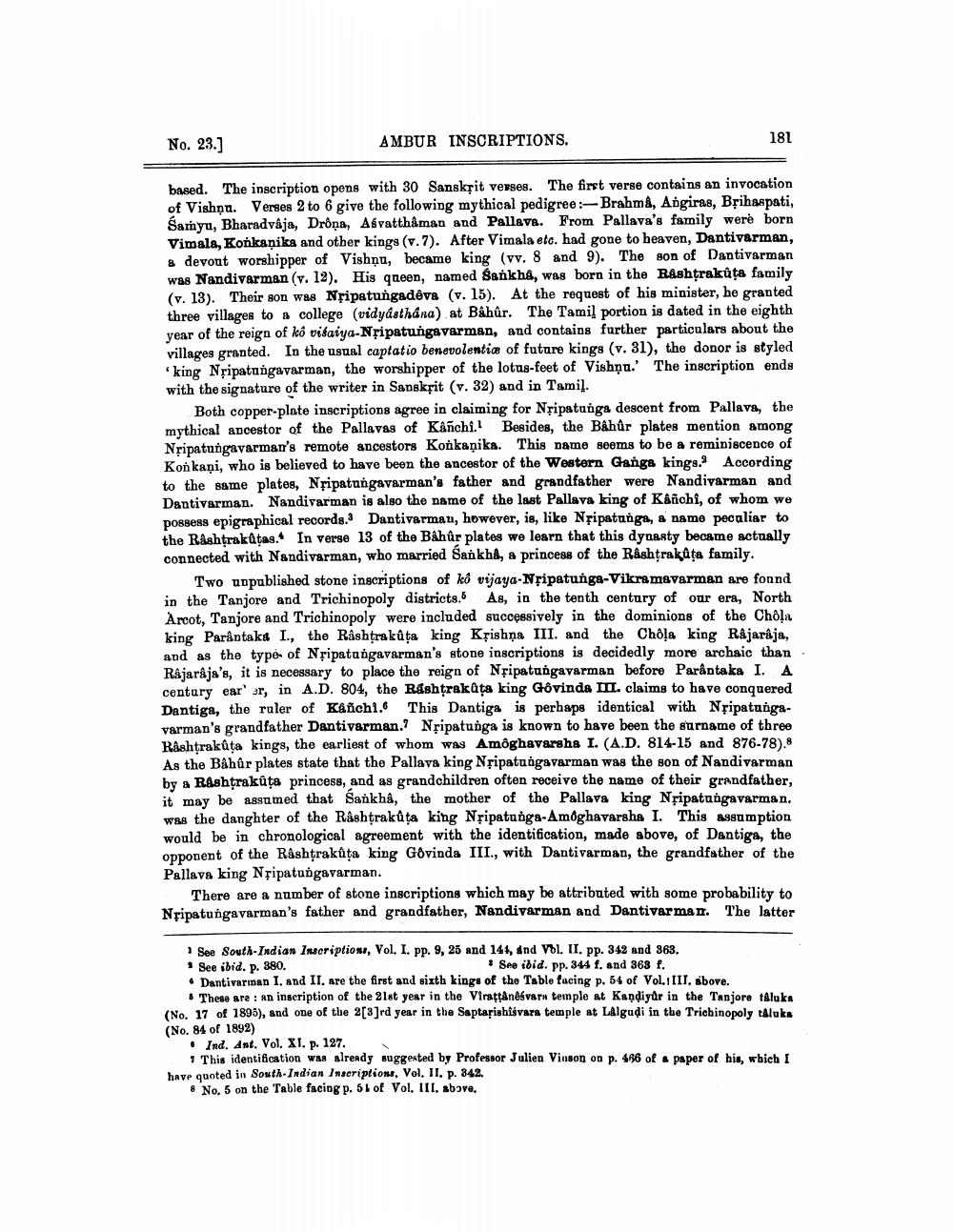________________
No. 23.]
AMBUR INSCRIPTIONS.
181
based. The inscription opens with 30 Sanskřit verses. The first verse contains an invocation of Vishnn. Verses 2 to 6 give the following mythical pedigree:-Brahma, Angiras, Brihaspati, Samyu, Bharadvaja, Drôņa, Asvatthâman and Pallave. From Pallava's family were born Vimala, Konkanika and other kings (v.7). After Vimala etc. had gone to heaven, Dantivarman, & devout worshipper of Vishņu, became king (vv. 8 and 9). The son of Dantivarman was Nandivarman (v. 12). His queen, named Sankhe, was born in the Rashtrakůţa family (v. 13). Their son was Nripatungadêve (v. 15). At the request of his minister, he granted three villages to a college (vidyasthana) at Bahûr. The Tamil portion is dated in the eighth year of the reign of ko visaiya-Nřipatungsvarmen, and contains further particulars about the villages granted. In the usual captatio benevolentiæ of future kings (v. 31), the donor is styled
king Nripatungavarman, the worshipper of the lotus-feet of Vishnu. The inscription ends with the signature of the writer in Sanskrit (v. 32) and in Tamil.
Both copper-plate inscriptions agree in claiming for Nripatunga descent from Pallava, the mythical ancestor of the Pallavas of Kanchi. Besides, the Bahûr plates mention among Nripatungavarman's remote ancestors Konkaņika. This Dame seems to be a reminiscence of Konkani, who is believed to have been the ancestor of the Western Ganga kings. According to the same plates, Nřipatungavarman's father and grandfather were Nandivarman and Dantivarman. Nandivarman is also the name of the last Pallava king of Kanchi, of whom we possess epigraphical records. Dantivarmau, however, is, like Nřipatunga, a name pecaliar to the Rashtrakūtas. In verse 13 of the Bahûr plates we learn that this dynasty became actually connected with Nandivarman, who married Sankha, a princess of the Rashtrakāta family.
Two unpublished stone inscriptions of kô vijaya-Nripatunga-Vikramavarman are fonnd in the Tanjore and Trichinopoly districts. As, in the tenth century of our era, North Arcot, Tanjore and Trichinopoly were included successively in the dominions of the Chola king Parântakt I, the Rashtrakūta king Kệishna III. and the Chola king Rajaraja, and as the type of Nripatangavarman's stone inscriptions is decidedly more archaic than Rajaraja's, it is necessary to place the reign of Nripatungavarman before Parântaka I. A century ear' ar, in A.D. 804, the R&shtrakata king Govinda III. claims to have conquered Dantiga, the ruler of Kanchi. This Dantiga is perhaps identical with Npipatungavarman's grandfather Dantivarman.? Nripatunga is known to have been the surname of three Rashtrakůta kings, the earliest of whom was Amôghavarsha I. (A.D. 814-15 and 876-78). As the Bâhûr plates state that the Pallava king Nřipatungavarman was the son of Nandivarman by a Rashtrakûţa princess, and as grandchildren often receive the name of their grandfather, it may be assumed that Sankhâ, the mother of the Pallava king Nřipatungavarman. Was the danghter of the Rashtrakūta king Nřipatunga-Amoghavarsha I. This assumption would be in chronological agreement with the identification, made above, of Dantiga, the opponent of the Rashtrakața king Govinda III., with Dantivarman, the grandfather of the Pallava king Nripatungavarman.
There are a number of stone inscriptions which may be attributed with some probability to Nipatungavarman's father and grandfather, Nandivarman and Dantivarman. The latter
1 See South Indian Inscription, Vol. I. pp. 9, 25 and 144, And Vol. II. pp. 342 and 363. . See ibid. p. 380.
Sne ibid. pp. 344 f. and 368 f. • Dantivarian I. and II. are the first and sixth kinge of the Table facing p. 54 of Vol.1 11. sbove.
. These are : an inscription of the 21st year in the Viraţtåndsvara temple at Kandiyar in the Tanjore tAluks (No. 17 of 1895), and one of the 2[3]rd year in the Saptarishisvara temple at Lalgudi in the Trichinopoly taluks (No. 84 of 1892)
• Ind. ant. Vol. XI. p. 127.
This identification was already suggested by Professor Julien Vinson on p. 486 of paper of his, wbich I have quoted in South Indian Inscriptions, Vol. II. p. 342.
8 No. 5 on the Table facing p. 51 of Vol. III, above.




